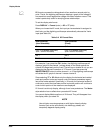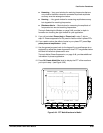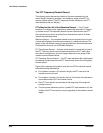
Reference
3Ć36
Fast Fourier Transforms
Advanced DSP Math (optional on TDS 620A & TDS 640A), provides the Fast
Fourier Transform (FFT). The FFT allows you to transform a waveform from a
display of its amplitude against time to one that plots the amplitudes of the
various discrete frequencies the waveform contains. Further, you can also
display the phase shifts of those frequencies. Use FFT math waveforms in
the following applications:
H Testing impulse response of filters and systems
H Measuring harmonic content and distortion in systems
H Characterizing the frequency content of DC power supplies
H Analyzing vibration
H Analyzing harmonics in 50 and 60 cycle lines
H Identifying noise sources in digital logic circuits
The FFT computes and displays the frequency content of a waveform you
acquire as an FFT math waveform. This frequency domain waveform is
based on the following equation:
X(k) +
1
N
N
2
* 1
Ă SĂ
n +
* N
2
x(n)e
*
j2pnk
N
Ă
Ă
ĂĂĂĂĂ
for : k + 0Ă toĂ N * 1
Where: x(n) is a point in the time domain record data array
X(k) is a point in the frequency domain record data array
n is the index to the time domain data array
k is the index to the frequency domain data array
N is the FFT length
j is the square root of −1
The resulting waveform is a display of the magnitude or phase angle of the
various frequencies the waveform contains with respect to those frequenĆ
cies. For example, Figure 3Ć20 shows the nonĆtransformed impulse reĆ
sponse of a system in channel 2 at the top of the screen. The FFTĆtransĆ
formed magnitude and phase appear in the two math waveforms below the
Description


















